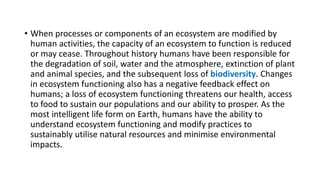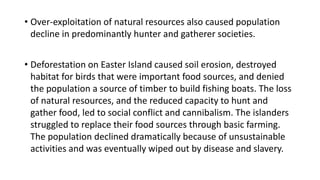Lesson 2.pptx
- 2. Why is this relevant to us? • Growing populations, economic growth and changes in lifestyle are placing pressure on natural resources and ecosystems. Humans must conserve and protect the environment so that social, economic and environmental functions are not degraded. All levels of society have a responsibility to protect cultural assets and conserve natural resources for fair access by future generations.
- 3. Inquiry questions • How can social and economic needs be met without degrading the environment? • What are the key threats to sustainability? • Why is intergenerational equity fundamental to the decisions we make about development? • How can we protect the Earth’s resources? • To what extent have human actions contributed to climate change in the previous 150 years?
- 4. Sustainability • Earth is home to 7 billion people and countless flora and fauna. Life is sustained by healthy ecosystems that are increasingly at risk of degradation from humans modifying the environment and over-exploiting natural resources. Humans depend on the biosphere to meet basic needs, but increasing development has led to pressure on natural resources. Humans can cause widespread changes that affect all living things, but we are intelligent enough to manage the biosphere properly.
- 5. A very significant indication of global warming is the changes that can be seen in the amount of ice in the Arctic Ocean and on the great ice caps of Greenland and Antarctica.
- 6. In 2006 -07, Australians generated approximately 48 million tonnes of waste. Only 52% of that waste was recycled.
- 7. More than 25% of the world's fish stocks are thought to be at the brink of depletion due to overfishing and habitat destruction.
- 8. The concept of sustainability • Sustainability generally refers to the capacity to use resources so that they are maintained for future use and managed in a way that brings about economic and social improvements without significant environmental degradation. The environment in which we live is a complex mix of natural and human features and includes different ecosystems that form the biosphere. Ecosystems are communities of flora and fauna that interact with each other principally soil, water and the atmosphere. All living things, including humans, depend on the interaction of the biological and physical processes that support ecosystem functioning.
- 9. • When processes or components of an ecosystem are modified by human activities, the capacity of an ecosystem to function is reduced or may cease. Throughout history humans have been responsible for the degradation of soil, water and the atmosphere, extinction of plant and animal species, and the subsequent loss of biodiversity. Changes in ecosystem functioning also has a negative feedback effect on humans; a loss of ecosystem functioning threatens our health, access to food to sustain our populations and our ability to prosper. As the most intelligent life form on Earth, humans have the ability to understand ecosystem functioning and modify practices to sustainably utilise natural resources and minimise environmental impacts.
- 10. Key terms • Biosphere: sum of all terrestrial and aquatic ecosystems • Biodiversity: the diversity of plant and animal life in a particular habitat.
- 11. Sustainable development • Since the 1980s, governments around the world have developed strategies to sustain human populations by integrating social, economic and environmental goals and values into decisions on development. In 1987 the Brundtland Commission of the United Nations proposed the following, now widely adopted definition of sustainable development: • Sustainable development is development that meets the needs of the present without compromising the ability of future generations to meet their own needs.
- 12. • This definition now commonly appears in laws, policies and guidelines for sustainable development. The Brundtland Report, from which this definition is sourced, identified three pillars for sustainable development: • economic growth – promotion of economic development to improve the standard of living of humans, particularly those in poverty, without degrading natural resources • environmental protection – to protect ecological processes and ecosystems • social equality – a focus on ensuring the wellbeing of humans and raising the standard of living of all people. Central to this is equal access to resources.
- 13. • These three pillars are also often presented as interacting components or overlapping spheres of sustainable development. How we manage one component involves an understanding of the effect on the other two components. Environmentalists are, however, critical of the formal definition of sustainable development, arguing that it is vaguely worded and does not mention the environment. Similarly, the term ‘sustainable development’ itself is considered to be ambiguous and open to interpretation.
- 14. History of sustainability • The need for sustainability can be traced back to 10 000 years ago when humans established permanent settlements supported by agriculture. Agrarian societies that over-exploited resources and were unable to adapt to natural and human-induced changes in the environment declined or disappeared. For example, intensive farming initially provided abundant food that enabled the population of Mesopotamia to grow dramatically. Irrigation was introduced to increase crop yields to feed the growing population. Irrigation salinised the soil and extensive areas of once-productive farmland were abandoned. By 1700 BC, the population of Mesopotamia was reduced by 60% from its peak as a result of soil salinisation, climate change, and over-exploitation of other natural resources.
- 15. • Over-exploitation of natural resources also caused population decline in predominantly hunter and gatherer societies. • Deforestation on Easter Island caused soil erosion, destroyed habitat for birds that were important food sources, and denied the population a source of timber to build fishing boats. The loss of natural resources, and the reduced capacity to hunt and gather food, led to social conflict and cannibalism. The islanders struggled to replace their food sources through basic farming. The population declined dramatically because of unsustainable activities and was eventually wiped out by disease and slavery.
- 16. • By contrast, societies that used sustainable practices, whether for farming or hunting and gathering, were able to maintain their populations. Before Europeans settled in Australia, Aboriginal and Torres Strait Islander peoples maintained their populations through hunting and gathering for over 40 000 years in very harsh environments. However, there is evidence they altered vegetation communities through the use of fire. Shifting cultivators in New Guinea and parts of South America continue to farm sustainably to the present day by reducing pressure on soils and avoiding widespread deforestation for farming. There are also many examples of agricultural societies that have farmed their land continuously for centuries in Asia despite large populations.
- 17. Key factors in the success or failure of societies include: • an understanding of the carrying capacity of the environment • an ability to use plant and animal food sources without loss of biodiversity • the resilience of the environment – that is, its ability to recover from environmental impacts • the intensity of human activities and the types of practices used to exploit resources • the ability to conserve soil, water and air quality • the capacity of humans to recognise and adapt to environment change.
- 18. Deforestation destroys habitat and exposes soil to erosion.
- 19. Key concepts in sustainable development • Intergenerational equity refers to the responsible use of natural resources to enable fair access to the same resources by future generations of humans. If today’s populations deplete the Earth of critical resources, such as topsoil to grow food and fossil fuels to generate electricity and power vehicles, future generations will have less opportunity to prosper. Prosperity is intrinsically linked to consumption of resources, but it can deplete non-renewable resources or reduce access to renewable resources if they are destroyed or unable to be replenished because of over- exploitation. Accordingly, intergenerational equity is a key component of policies, laws and other management approaches that have sustainable development as a primary goal. Whether it can be achieved is highly contentious because the rate of urbanisation and growth in human population is increasing consumption of resources.
- 20. Uncertainty, risk and precaution • Sustainable development of Earth’s resources involves the challenge of dealing with uncertainty and risk. In the context of sustainable development, uncertainty refers to our inability to be absolutely certain of the outcomes and risks of modifying the environment to meet our needs. Predicting the impacts of development depends on sound scientific knowledge of Earth’s processes and how our actions modify them. For example, we know that humans have the potential to change climate by modifying atmospheric processes through pollution. Changing climate is a risk to the environment because it may increase sea levels, destroy temperature-sensitive ecosystems and cause local extinction of flora and fauna.
- 21. Uncertainty, risk and precaution • Changes in temperature and water availability, along with the submergence of land from rising sea levels, can destroy habitat and lead to loss of species. The extent to which we influence climate has high levels of uncertainty. We are uncertain of the magnitude and the timing of climate change, and we are uncertain of how the environment will respond. Furthermore, we are uncertain over the management actions that can mitigate the negative impacts yet are compelled to develop in order to prosper. Stakeholder conflicts over development often involve debates about the level of uncertainty and environmental risks.
- 22. Geographical Facts! • More than 25% of the world’s fish stocks are thought to be at the brink of collapse due to overfishing and habitat destruction. • Some villages around the world are entirely sustainable. The people of Awana Kancha in Peru have no need for cash. They raise their own animals, spin their own fabric and grow their own food. • More than 20% of species are predicted to become extinct in the next 25 years. More than half of all current species could become extinct within 100 years. • As water heats up, it expands. Approximately half of the past century’s rise in sea level is attributable to warmer oceans occupying more space.
- 23. Research task • Complete the research task on the Mayan or Anasazi civilisations
- 24. Research Task • Search for information on the Mayan or Anasazi civilisations. Use ‘environmental degradation’ as a search term. Research only one of these civilisations and answer the following: 1. Identify which activities were thought to have caused environmental degradation. 2. Evaluate whether there were any natural changes to the environment that might have also been a factor in the decline of the society. 3. Explain why the society was unable to find a solution. 4. Distinguish which lessons can be learned from the experiences of the society.























